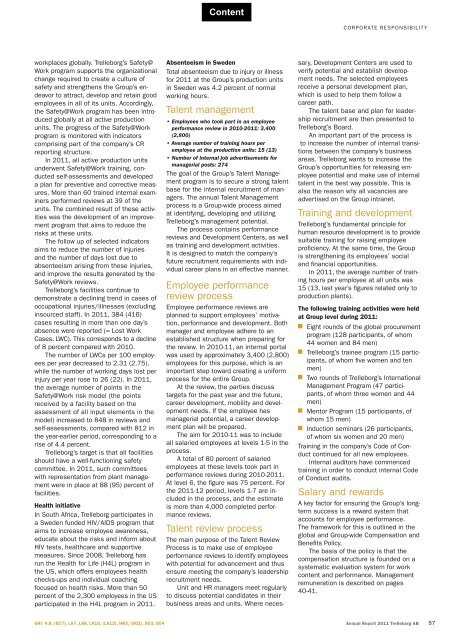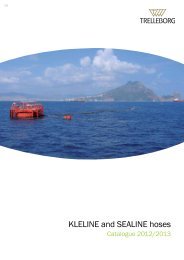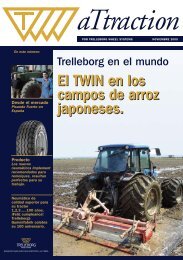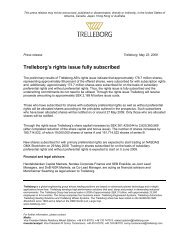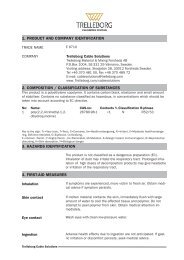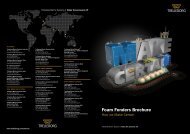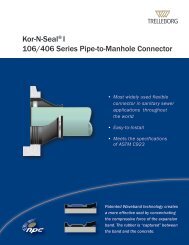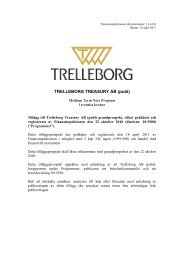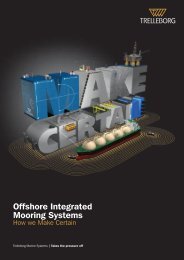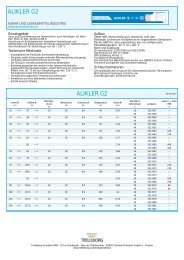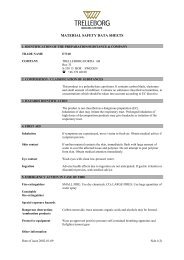Annual report 2011 - Trelleborg
Annual report 2011 - Trelleborg
Annual report 2011 - Trelleborg
Create successful ePaper yourself
Turn your PDF publications into a flip-book with our unique Google optimized e-Paper software.
workplaces globally. <strong>Trelleborg</strong>’s Safety@<br />
Work program supports the organizational<br />
change required to create a culture of<br />
safety and strengthens the Group’s endeavor<br />
to attract, develop and retain good<br />
employees in all of its units. Accordingly,<br />
the Safety@Work program has been introduced<br />
globally at all active production<br />
units. The progress of the Safety@Work<br />
program is monitored with indicators<br />
comprising part of the company’s CR<br />
<strong>report</strong>ing structure.<br />
In <strong>2011</strong>, all active production units<br />
underwent Safety@Work training, conducted<br />
self-assessments and developed<br />
a plan for preventive and corrective measures.<br />
More than 60 trained internal examiners<br />
performed reviews at 39 of the<br />
units. The combined result of these activities<br />
was the development of an improvement<br />
program that aims to reduce the<br />
risks at these units.<br />
The follow up of selected indicators<br />
aims to reduce the number of injuries<br />
and the number of days lost due to<br />
absenteeism arising from these injuries,<br />
and improve the results generated by the<br />
Safety@Work reviews.<br />
<strong>Trelleborg</strong>’s facilities continue to<br />
demonstrate a declining trend in cases of<br />
occupational injuries/illnesses (excluding<br />
insourced staff). In <strong>2011</strong>, 384 (416)<br />
cases resulting in more than one day’s<br />
absence were <strong>report</strong>ed (= Lost Work<br />
Cases, LWC). This corresponds to a decline<br />
of 8 percent compared with 2010.<br />
The number of LWCs per 100 employees<br />
per year decreased to 2.31 (2.75),<br />
while the number of working days lost per<br />
injury per year rose to 26 (22). In <strong>2011</strong>,<br />
the average number of points in the<br />
Safety@Work risk model (the points<br />
received by a facility based on the<br />
assessment of all input elements in the<br />
model) increased to 848 in reviews and<br />
self-assessments, compared with 812 in<br />
the year-earlier period, corresponding to a<br />
rise of 4.4 percent.<br />
<strong>Trelleborg</strong>’s target is that all facilities<br />
should have a well-functioning safety<br />
committee. In <strong>2011</strong>, such committees<br />
with representation from plant management<br />
were in place at 88 (95) percent of<br />
facilities.<br />
Health initiative<br />
In South Africa, <strong>Trelleborg</strong> participates in<br />
a Sweden funded HIV/AIDS program that<br />
aims to increase employee awareness,<br />
educate about the risks and inform about<br />
HIV tests, healthcare and supportive<br />
measures. Since 2008, <strong>Trelleborg</strong> has<br />
run the Health for Life (H4L) program in<br />
the US, which offers employees health<br />
checks-ups and individual coaching<br />
focused on health risks. More than 50<br />
percent of the 2,300 employees in the US<br />
participated in the H4L program in <strong>2011</strong>.<br />
Absenteeism in Sweden<br />
Total absenteeism due to injury or illness<br />
for <strong>2011</strong> at the Group’s production units<br />
in Sweden was 4.2 percent of normal<br />
working hours.<br />
Talent management<br />
• Employees who took part in an employee<br />
performance review in 2010-<strong>2011</strong>: 3,400<br />
(2,800)<br />
• Average number of training hours per<br />
employee at the production units: 15 (13)<br />
• Number of internal job advertisements for<br />
managerial posts: 274<br />
The goal of the Group’s Talent Management<br />
program is to secure a strong talent<br />
base for the internal recruitment of managers.<br />
The annual Talent Management<br />
process is a Group-wide process aimed<br />
at identifying, developing and utilizing<br />
<strong>Trelleborg</strong>’s management potential.<br />
The process contains performance<br />
reviews and Development Centers, as well<br />
as training and development activities.<br />
It is designed to match the company’s<br />
future recruitment requirements with individual<br />
career plans in an effective manner.<br />
Employee performance<br />
review process<br />
Employee performance reviews are<br />
planned to support employees’ motivation,<br />
performance and development. Both<br />
manager and employee adhere to an<br />
established structure when preparing for<br />
the review. In 2010-11, an internal portal<br />
was used by approximately 3,400 (2,800)<br />
employees for this purpose, which is an<br />
important step toward creating a uniform<br />
process for the entire Group.<br />
At the review, the parties discuss<br />
targets for the past year and the future,<br />
career development, mobility and development<br />
needs. If the employee has<br />
managerial potential, a career development<br />
plan will be prepared.<br />
The aim for 2010-11 was to include<br />
all salaried employees at levels 1-5 in the<br />
process.<br />
A total of 80 percent of salaried<br />
employees at these levels took part in<br />
performance reviews during 2010-<strong>2011</strong>.<br />
At level 6, the fi gure was 75 percent. For<br />
the <strong>2011</strong>-12 period, levels 1-7 are included<br />
in the process, and the estimate<br />
is more than 4,000 completed performance<br />
reviews.<br />
Talent review process<br />
The main purpose of the Talent Review<br />
Process is to make use of employee<br />
performance reviews to identify employees<br />
with potential for advancement and thus<br />
ensure meeting the company’s leadership<br />
recruitment needs.<br />
Unit and HR managers meet regularly<br />
to discuss potential candidates in their<br />
business areas and units. Where neces-<br />
CORPORATE RESPONSIBILITY<br />
sary, Development Centers are used to<br />
verify potential and establish development<br />
needs. The selected employees<br />
receive a personal development plan,<br />
which is used to help them follow a<br />
career path.<br />
The talent base and plan for leadership<br />
recruitment are then presented to<br />
<strong>Trelleborg</strong>’s Board.<br />
An important part of the process is<br />
to increase the number of internal transitions<br />
between the company’s business<br />
areas. <strong>Trelleborg</strong> wants to increase the<br />
Group’s opportunities for releasing employee<br />
potential and make use of internal<br />
talent in the best way possible. This is<br />
also the reason why all vacancies are<br />
advertised on the Group intranet.<br />
Training and development<br />
<strong>Trelleborg</strong>’s fundamental principle for<br />
human resource development is to provide<br />
suitable training for raising employee<br />
profi ciency. At the same time, the Group<br />
is strengthening its employees’ social<br />
and fi nancial opportunities.<br />
In <strong>2011</strong>, the average number of training<br />
hours per employee at all units was<br />
15 (13, last year’s fi gures related only to<br />
production plants).<br />
The following training activities were held<br />
at Group level during <strong>2011</strong>:<br />
Eight rounds of the global procurement<br />
program (128 participants, of whom<br />
44 women and 84 men)<br />
<strong>Trelleborg</strong>’s trainee program (15 participants,<br />
of whom fi ve women and ten<br />
men)<br />
Two rounds of <strong>Trelleborg</strong>’s International<br />
Management Program (47 participants,<br />
of whom three women and 44<br />
men)<br />
Mentor Program (15 participants, of<br />
whom 15 men)<br />
Induction seminars (26 participants,<br />
of whom six women and 20 men)<br />
Training in the company’s Code of Conduct<br />
continued for all new employees.<br />
Internal auditors have commenced<br />
training in order to conduct internal Code<br />
of Conduct audits.<br />
Salary and rewards<br />
A key factor for ensuring the Group’s longterm<br />
success is a reward system that<br />
accounts for employee performance.<br />
The framework for this is outlined in the<br />
global and Group-wide Compensation and<br />
Benefi ts Policy.<br />
The basis of the policy is that the<br />
compensation structure is founded on a<br />
systematic evaluation system for work<br />
content and performance. Management<br />
remuneration is described on pages<br />
40-41.<br />
GRI: 4.8, (EC7), LA7, LA8, LA10, (LA12), HR3, (SO2), SO3, SO4 <strong>Annual</strong> Report <strong>2011</strong> <strong>Trelleborg</strong> AB 57


